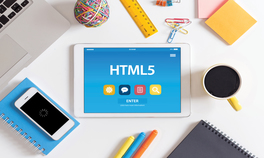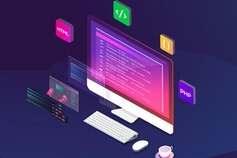
If you’re building a house, you don’t start by gathering paint. Instead, you grab the bricks and mortar you need to construct a strong foundation. In professional web development, HTML (HyperText Markup Language) serves a similar purpose to the bricks and mortar of a building. No matter how fancy your website might be, you need it to craft a sturdy underlying structure.
Today, HTML knowledge is necessary for anyone who wants to build, manage or improve websites — from professional developers to marketers and small-time business owners. In this article, we’ll cover HTML basics and explain what you need to know about the language before you start learning. We’ll also spotlight a few careers where HTML knowledge comes in handy and map out your timeline for achieving proficiency in the language.
What Is HTML?
HTML, which stands for “Hypertext Markup Language,” is the language used to create, structure and design websites. The term “hypertext” refers to HTML’s ability to link out to relevant content. As a markup language, tags are used in HTML to define the overall structure and layout of a webpage, as well as the content elements within it.
At its most fundamental level — before extra styling and dynamic elements are applied — HTML tags tell your web browser what to display on the screen and in what order. When coding for the web, you wrap or enclose different parts of your content to ensure that it appears where, when and how you want. Basic HTML tags can determine font size as well as basic formatting choices such as bold or italics.
While the kind of content, design and dynamism that we see on the web has changed dramatically over the past few decades, HTML has remained the fundamental framework that powers web design. Even dynamic websites generated by more advanced scripting languages such as Javascript or PHP rely at least in part on HTML. This is why learning to code in HTML continues to be essential for web developers.
History of HTML
HTML was first invented by Tim Berners-Lee in 1993, though the language was not widely used until 1999, when HTML 4.01 became an official standard for web development. In 2012, the language was updated into HTML5, which offered expanded capabilities.
Interestingly, modern HTML codebases tend to be shorter than early ones. Many of the design and interactive elements that developers used to code manually are now handled with CSS (Cascading Style Sheets) or JavaScript.
Why Learn HTML?
As we’ve already mentioned, HTML is a foundational skill for anyone who has a passing or professional interest in web development.
The language is handy even for those who aren’t looking to make their living by building websites! A small business owner, for example, could cut costs by constructing and managing their site personally. Even if you work with pre-built web solutions, having a little HTML savvy will allow you to solve basic problems and customize your site without customer service or external help.
Plus, HTML is a fantastic introductory language if you’re only just starting to code. By taking an HTML course, you can teach yourself how to think like a coder. This mindset shift will serve you well if you opt to pursue further education in data science or web development.
Skills covered in these tutorials:
- Meta Elements
- Open & Close Tags
- Structural Elements
- Doctypes
- Nesting Elements
- Attributes
HTML Basics
Not sure what you need to know about HTML before you learn? We’ve got you covered. In this section, we’ll discuss the fundamentals of how and why HTML works.
Basic HTML elements and tags
If you enroll in a course covering the basics of HTML, one of the first concepts you’ll learn will be elements. Elements structure page content by enclosing it in “tags” that provide instructions on how that content should appear.
Every HTML tag begins with an open angle bracket (<) and closes with a closed angle bracket (>). A forward slash before the name of the element closes a particular tag, and HTML tags can nest inside one another. It is essential to close every HTML tag you open. To give you a quick HTML tutorial for beginners, here is one of the most basic HTML tags: “p”, which stands for “new paragraph.”
As you can see, the opening “p” tag begins the paragraph, and the closing tag ends it. This entire HTML snippet is referred to as an HTML element. Other very basic and common HTML tags include “strong”, for bolded content, and “i” or “em”, for italicization.
Structure of an HTML element
A basic HTML element has three parts:
- Opening tag: This is the element’s name, wrapped in angle brackets, as above, with the paragraph tag.
- Closing tag: This is the same as the opening tag, but it has a forward slash before the element’s name. Forgetting a closing tag is a common mistake and can lead to conflicts or unexpected results.
- Content: This is the content that the tags are meant to display and can include text, images or other featured material.
Opening and closing tags
Opening and closing tags are crucial to HTML elements. They tell a web browser when a certain piece of content begins and ends, thereby separating it from other page sections. Forgetting a closing tag can make your HTML content appear unusual or wrong. When developers troubleshoot HTML problems, searching for missing closing tags is usually one of their first steps.
HTML tags can be nested inside one another. For example, you could use the “strong” tag to nest a bolded word or phrase inside a “p” paragraph element. As with any nesting item, make sure to close the inner tags before closing the outer tags; the browser will not know how to properly process your content if you fail to distinguish your elements.
Content
Content refers to any text, code, table, media or other information presented on a webpage. However, not all HTML elements need to have a closing tag or specified content. These are called empty elements. Don’t let the name mislead you into thinking these elements don’t add anything to the page — they do!
In fact, one of the most common empty elements is an image element, which points to the location of an image. There is no inner content; instead, HTML image elements refer to an image in a specified location on the web and embed it within the page’s structure.
Attributes
Elements can have attributes specified within the opening tag that help to define them further. One of the most common attributes in HTML are classes, which CSS often uses to define the appearance of certain parts of a webpage. Here’s a quick example of what this might look like:
In this example, “new-para” is the class name associated with this paragraph. For this to have meaning, you would need to define and use the new-para value elsewhere. You could use the same class value for other HTML elements that you want to look the same. When you add an attribute value, wrap it in opening and closing quotation marks for best results.
Other types of attributes are widely used in image and other media elements. Here’s a quick HTML tutorial for beginners:
Here, “src,” for “source,” tells the browser where to find the image. Alt tags describe the picture; these are considered an essential part of HTML content because they make image content accessible to search engines and people who use screen readers.
Block elements and inline
In HTML, block-level elements always begin on a new line and take up the full width of a page. Each block-level element has a top and bottom margin around it. Some of the elements we’ve already discussed, including <p>, are block elements.
There are countless others; for example, lists, which use the <ol> and <ul> tags, are block-level elements. Similarly, an HTML table is a block-level element that can be used to structure tabular data (i.e., information organized in rows and columns).
On the other hand, inline elements take up only as much width as they need and are often used inside other elements. For example, <br> is used to create a line break without making a new paragraph. Styling elements like <strong> or <em> also are inline elements, among many others. <img> elements are designed to be inline elements so that an image may fit alongside other HTML content and not require a new line of its own.
Headlines, paragraphs and lists
While some people write HTML directly into a plain text editor like Notepad, you can use specialized HTML editors to facilitate the coding process. HTML editing software can help you produce code with fewer errors by debugging as you write. Using an HTML editor can also alleviate common concerns such as forgotten closing tags or missing “alt” attributes for image elements.
In HTML5, you can choose to use CSS for the majority of your styling. However, basic HTML elements can help you to distinguish one part of your writing from another. Headlines or header text are some of the most commonly used types of HTML elements. By using headers, numbered in size from 1 (the largest) to 6 (the smallest), you can define sections of your text with these simple <h1> </h1> or <h3> </h3> tags.
HTML lists can also help to order your content by creating bulleted or numbered lists that make your written content clearer and more concise. There are a few types of lists — for example, while the <ul> tag creates an unordered or bulleted list, the <ol> tag creates an ordered or numbered list. Each list item is enclosed in <li> tags.
You may also make use of HTML color codes to define the colors of your text. You can use CSS for more color complexity, but you can access the full scale of hexadecimal color codes in any HTML document or webpage.
HTML forms
In simple terms, HTML forms tell a web browser what kind of information to take from a user and how to process it.
Each HTML form is enclosed within a <form> tag, but the capabilities they provide are remarkably diverse. Even the most dynamically-constructed websites use HTML forms to receive information from visitors, process payments, manage memberships and allow people to log in to their accounts.
Get Program Info
Who Needs to Learn HTML and How Is It Used?
As we mentioned during our “Why You Should Learn HTML” section, this coding language is a necessity for web developers and a good skill for all other professionals to have. Learning HTML can provide tremendous value to people working in tech, as well as to those who are running their own business or managing a website. Even if you just want to create an online portfolio for your work, HTML can be a fantastic skill to have in your repertoire.
Below, we’ve spotlighted a few of the professional roles that could benefit from — or outright require — HTML proficiency.
Web designer
It’s intuitive — web designers need to know how their designs will translate on a physical web page. While web designers don’t necessarily need to have the coding skills that web developers have, they should at the very least have a basic understanding of HTML and web coding. Having this fundamental knowledge will allow designers to create plans that uphold functionality and avoid aesthetic choices that would cause significant coding challenges.
Webpage owner
Whether you are a blogger, influencer or an entrepreneur who wants to have a sleek virtual storefront, HTML is a crucial skill to have in your pocket. If you want to build or make edits to your site without needing to ask (or hire!) outside help, you need to know HTML.
Front end developer
HTML might be important for web design, but it’s downright essential if you plan to make a living as a front end developer. These professionals are responsible for building and managing every part of a website that a viewer might see or interact with. Front end developers use HTML-based coding frameworks like Bootstrap, which are designed to support web development and tend to have well-honed skills in other front end languages like CSS and JavaScript.
Marketer
If you want to make attractive online stores or create marketing copy that grabs the eyes as well as the mind, HTML would be a great tool in your wheelhouse. If you know how to code HTML yourself, you won’t need to send your copy out for others to design and post on the web; you can handle it yourself. Basic coding knowledge will make you more capable as a marketer — and potentially bolster your earning potential.
IT technician
HTML isn’t reserved for web development. If you’re an IT technician tasked with managing your company’s intranet, you’ll use HTML to do so; if you need to fix a problem with your company’s site, knowing HTML is key to providing quick repairs. Even if you mainly work in cybersecurity or networking, HTML knowledge can help you locate potential gaps or vulnerabilities in your employer’s site and give you a stronger basis for your work.
UX designer
As the title suggests, User Experience (UX) designers are responsible for creating an enjoyable experience for users. UX design can overlap heavily with web design, especially as web-based content is often part of the overall user experience for digital products.
Having HTML knowledge can help you expand your understanding of web design principles and push the boundaries of what an online experience can entail. If you need to conduct user research, knowing how to gather and process data via HTML forms and analytical tools, respectively, will be vital. HTML is a solid foundational skill for UX designers who specialize in digital or web products.
How Long Does It Take to Learn HTML?
The time it takes to learn HTML can vary from person to person. If you already have some tech knowledge or have dabbled in HTML, you can get your HTML up to speed in a matter of weeks or months.
You can also learn to use HTML alongside other key technologies, like CSS and JavaScript, as part of a structured learning experience like a coding bootcamp focusing on full stack web development. These intensive programs can be completed in three months full-time or six months part-time. They will equip you not only with HTML experience but also a full suite of web development knowledge. Upon your graduation, you’ll be ready to start searching for entry-level coding jobs right away.
What Other Skills/Languages Should I Learn?
If you are considering a career in web development, you’ll need to complement your HTML knowledge with CSS and JavaScript skills as well. Understanding how to use these three languages is essential if you plan to make a living as a front end web developer. If you want to go beyond the front end basics and into full stack development, you may also want to study up on coding frameworks such as Bootstrap, Django or Node.js, as well as database query languages like SQL and back end languages such as Python.
Accumulating these skills will put you on a path towards full stack development. While front end developers focus primarily on the user-facing aspects of a site, full stack developers combine front end development tactics and the back end (server-side) techniques that give websites their functionality.
Full stack development is a fantastic career path with excellent growth potential — however, it’s difficult to break into the field through self-study alone. If you want to hone your skills and upskill into the job pool quickly, you may want to consider enrolling in coding bootcamp. As we mentioned earlier, this educational option provides a swift, structured and effective way to obtain the practical skills you need to land your first coding job and begin your career journey.
Interested in finding out what a bootcamp could do for your career? Check out Berkeley Coding Boot Camp and Berkeley Data Analytics Boot Camp for inspiration, and contact us if you need any insights into how a bootcamp could support your professional growth!
HTML FAQ
HTML is used for structuring websites and organizing content within a web page. It is one of the fundamental “building block” languages of front end development, alongside CSS and JavaScript.
HTML is very accessible and serves as a great introduction for people who are new to coding. Many HTML tags are based on English words, so for English speakers, it’s generally easy to grasp the language’s concepts and syntax.
HTML is a markup language. While it is a form of coding, it is not a programming language per se. However, it is an excellent introductory skill that intersects with many full-featured programming languages used to build dynamic websites.
You can use several WYSIWYG (what you see is what you get) tools — think Wix, Squarespace, WordPress — that allow you to design a website visually. However, if you want to correct problems and understand what is happening on your site, taking an HTML course is essential.
Navigate HTML Articles
From basic knowledge to more advanced HTML coding techniques.
Get Program Info
Ready to learn more about Berkeley Coding Boot Camp in San Francisco? Contact an admissions advisor at (510) 306-1218.
 Live Chat
Live Chat




